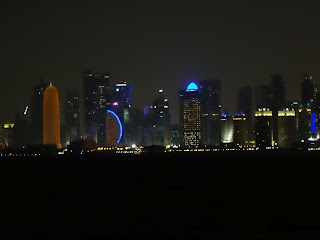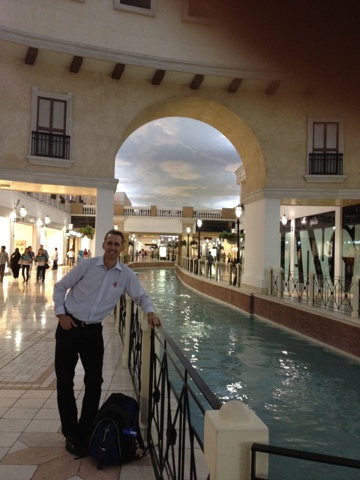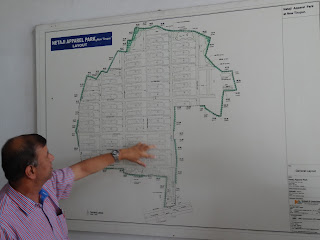Friday, 28 September 2012
Sept 28th The Last Qatar
Having gone from riding camels to watching them being sold and slaughtered, we finally got to eat camel in a Moroccan restaurant on our last night in this wonderful country. Following our meal we tried another local custom a 'Shisha' a strange looking contraption that has fruit flavored tobacco put into it. The tobacco is heated with coals and the sweet scented smoke sucked through a water filter. We tried two flavours apple and mint.
Sept 28th Operation Desert Storm
The plan was to go and see a camel race, but would you believe that it got rained out. In an country that only receives 70mm of rain per year, a freak thunderstorm dropped what looked like 50mm on the race track. Minor flooding and storm damage resulted and the race was called off. We still got to ride the racing camels, and see the robot jockeys. The premier camel race is the Sword of prince, worth $1 million in prize money.
Sept 27th Cruising Around Doha Port
A balmy evening on the sea enjoying a BBQ with our Qatar friends, a lazy swim in the warm gulf waters, doing bombers off the boat, while enjoying the beautiful skyline of Qatar at night. A great way to finish a hot day.
Sept 27th Mawashi Livestock
The live sheep and cattle trade from Australia has been a contentious issue from Animal liberationists within Australia for some time. Visiting Mawashi, gave us a great perspective of how this trade is operating within the Middle East. It was great to see how the work that the MLA has been doing to improve livestock handling of Australian sheep and cattle is paying off by also improving the way local livestock is handled. It is a slow process but significant inroads are being made. If live export was banned the traders would source stock from other less caring markets, which would have no desire to invest in changing the traditional practices.
The livestock Doha markets we're an amazing array of different sheep breeds, cattle and camels, all for sale for meat.
The livestock Doha markets we're an amazing array of different sheep breeds, cattle and camels, all for sale for meat.
We also visited the Veg & fish markets. For my Riverland friends, I found a fish that comes out of Qatar and looks very much like a Murray cod. See what you think?
Wednesday, 26 September 2012
Sept 26th Hassad Food
We began the morning with a visit to Hassad foods head
office to be briefed on their business.
Hassad Foods is a Qatar based company established in
2008 with a capital of $1billion. It was initially set up by the Qatar Royal
family to ensure food security for their nation. It has now changed some what
to be more commercially driven toward investing in Agriculture. Its strategy is to invest in five key areas of
Agricultural production to ensure its food security. These are Wheat, Sheep,
Poultry, Sugar, & Rice.
Hassad are very much a community conscious investor, http://www.hassad.com.au/ . Australia is one of their key areas of
investment due to its stable government and, because it already supplies a
significant amount of product to Qatar . They have purchased 90 farms
totaling 250, 000ha in Australia .
After our briefing we visited 'Irrekaia' one of the four farms Hasad
owns in Qatar .
It is a grass farm that produces irrigated hay using treated effluent from the
city of Qatar .
This is all sold into the local market for people to feed their livestock.
The amazing thing for me was that they were using Rohdes grass for making their hay. We consider this grass one of the worst summer weeds we have to contend with in our cropping programme. I can now understand why it grows so well in our soils after seeing the conditions it was growing in.They were achieving 9 cuts of grass per year at 5t/ha per cut, In conditions where daytime temperatures reach up to 50 degrees C in summertime.
This is the type of soil the crop I am kneeling in was being grown in, yes it is basically limestone.
The surrounding country side is virtually a barren moonscape, It reminded me a bit of Coober Peedy in Australia.

Most of the soils in Qatar are like this, have a look at this soil pit I came across, basically limestone all the way down. I would not have thought anything could have grown on this. It just goes to show, that all you need to add is water and nutrition and you can just about grow anything anywhere.
A 2.5 meg turkey nest dam used to irrigate one of the pivot sites. Each pivot receives equivalent to a dam full of water each day.
I was very impressed with the front gate to this farm, I think I will have to take some inspiration home from this to improve my front gate.
Tuesday, 25 September 2012
September 25th The Doha round of talks
After an early start in Dehli, we flew to Doha the capital of Qatar. Qatar has a population of about 2 million and is supposed to have the highest per capita income in the world. Despite this the people of Qatar are very price sensitive in their purchasing. This can be traced back to their strong trading roots. Below are pictures of an amazing shopping mall we visited in Doha. It was decked out like Venice complete with canals down the centre with gondolas on and a ceiling painted with clouds and the sky to give a perspective of being outdoors
Monday, 24 September 2012
Sept 24th Delhi briefing
Our last day on India was mostly spent in meetings learning about present and future directions for Indian agriculture, trade opportunities, and fund investment into India. Some interesting stats we learnt about India are;
It is 2.4% of Global landmass
Has 16% of global population
Population growth 18mill per year
Life expectancy is 67years
Dry land agriculture is 60% rest is irrigated, 70 to 80% of irrigation is groundwater based
After the briefings we visited a slum area to see first hand the work being done by Asha an NGO aid agency. The group was very surprised how happy these people were living in the slums
We finished our last day in India with a quick trip to the Delhi gate, the presidents house, and a lovely spicy curry tea.
It is 2.4% of Global landmass
Has 16% of global population
Population growth 18mill per year
Life expectancy is 67years
Dry land agriculture is 60% rest is irrigated, 70 to 80% of irrigation is groundwater based
After the briefings we visited a slum area to see first hand the work being done by Asha an NGO aid agency. The group was very surprised how happy these people were living in the slums
We finished our last day in India with a quick trip to the Delhi gate, the presidents house, and a lovely spicy curry tea.
Sept 23rd Ludhiana to Chandigarh
We started the morning with a quick trip round the Punjab Agriculture University, then headed to Raj's fish world to check out his fish farm. Raj had been one of our hosts while we have been in the Punjab provence, and the longer we were with him the more we discovered what an amazing businessman he is. He grows out fingerling fish in dams to then place in huge irrigation canals to finish. He also makes fish leather and plans to diversify into growing muscles for pearls, not to forget growing organic rice.
We also visited a turf farm, the only one in India at the moment. They currently have one outlet store and also market over the Internet. With the rising incomes in India i think this business is going to boom in the future.
After another lunch of fantastic curries in a hotel on the banks of one of the irrigation channels (Was nearly as big as the River Murray), we drove on to Chandigarh airport to fly out to Delhi.
We also visited a turf farm, the only one in India at the moment. They currently have one outlet store and also market over the Internet. With the rising incomes in India i think this business is going to boom in the future.
After another lunch of fantastic curries in a hotel on the banks of one of the irrigation channels (Was nearly as big as the River Murray), we drove on to Chandigarh airport to fly out to Delhi.
Saturday, 22 September 2012
September 22nd Punjab Agricultural University Fair
We were hosted today at the Punjab Agriculture University Fair. It is much like a cross between a field day and an Australian Agricultural show only slightly bigger. It is held over two days on the 300ha PAU site, and we were told that million people would visit the fair during those two days. It showcased the latest in Indian Ag machinery aimed at mechanising their small scale agricultural producers. Interestingly we read an article in a local newspaper that said the fair was too high tech, and out of reach for the average farmer. There were also great examples of the education and extension work being done by the university, with a large number of sites dedicated to providing farmers with information. Farmers travel up to 300km to visit the fair. During the fair we were presented with plaques honoring our visit.
Friday, 21 September 2012
Sept 21st Ludhiana, Punjab Provence
Our hosts Mali & Raj organised a great day for us. Spending time with local farmers in the Punjab, we discussed the differences and commonalities between farming in our respective countries. We also inspected some very nice crops of rice and maize. We also had an enlightening visit to "Field Fresh", a business growing and packing
home brand veges for tesco and other supermarkets.
home brand veges for tesco and other supermarkets.
Thursday, 20 September 2012
September 20th The Golden Temple in Amritsar
We left Mysore & flew to Amritsar via Dehli. We met up with our wonderfull hosts Mali & Raj at the Amritsar airport. After checking in at our hotel and Lunch, we headed to the “Golden Temple ” in Amritsar . This Sikh temple was built in the 1600’s and was amazing. The roof is covered with 24 carat gold 12mm thick and the spires are solid gold. One million people per day visit this temple. An amazing experience……..
Sept 19th Salem Dairy & Silk Production
Our host was Shane Whittaker an
Ozi expat who is a specalist in dairy heard development with Hatsun Agro Pty Ltd,
an Indian Dairy processor.
The size of Indian dairy heards
vary from 1 cow to 800 cows. We visited a typical farm which had 10 cows of which
8 were milking. The cows are housed in sheds and all their feed was hand cut
and bought to them. As with most small
farms the dairy heard was only a sideline, they also had a yarn spinning
business, grew coconuts and other crops.
One quite interesting thing was the small simple bio digester which was used to produce gas for cooking in the house, with future plans to generate electricity. Pictured below,it was powered by a slurry of cow manure and water poured into the hollow pipe on the left. As gas is produced it builds up pressure in the membrane under the tyres and is piped out via the blue hose, to the house, quite simple but effective.
Milk is collected by milk cans as it was in Australia 50 years ago, it takes about 4hrs from milking till it reaches the factory, no cold chain here until it is chilled in the factory.
Hatsuns dairy processing factory was amazing, I especially enjoyed the ice creamery (The icecream was fantastic to) In this part of the factory they used 50,000lt of milk per day to make icecream, mostly packaged in small single serve containers, that’s a lot of icecreams. I have included some video fottage so you can understand the scale of labour used in this area of the factory. I appologise for the footage quality, I’m still learning how to use my camera.
We visited another small mixed farm
which had a silk worm enterprise, these hungry little suckers plough through
Mulberry leaves like you wouldn’t believe. They produce their famous silk cocoons
in just 30 days from hatching. An interesting fact is that the warmer the
temperatures the yellower the silk produced, with the pale silk offering
the highest prices.
Sept 18th Evening....Dinner at the millionaires club
We enjoyed a fantastic evening with a group of coffee and pepper farmers. They spoke English very well and delighted us with their company. It was an hour long journey from Salem up a very steep winding road, and afforded fantastic views of the night lights of Salem. We enjoyed enthusiastic discussions with them on issues such as wether there is poverty in India and the practice of arranged marriages. All in all a very enjoyable evening.
Sept 18th Ponni sugar refinery
This is the sugar refinery that works closely with Ramesh. I was impressed how keen they were to work with Ramesh and their growers to improve productivity.
September 18th
We visited Netaji
Apparel Park
We also visited one of the factories sowing the apparel which
was a real eye opener. It was very clean, well set up and very well run, a good
example of the strong standards that they need to comply to. The factory runs
24hrs/day in two shifts.The companies in the park find it difficult to compete on price with China & Bangladesh , however they have built strong relationships with their customers which is ensuring their success. Their customers include LAPD, GAP clothing, Crew, Marks & Spencer.
Our second stop for the day was a Organic fertiliser business run by our good friend & guide Ramesh. We received a wonderful welcome from his loyal hardworking staff. Ramesh is turning cane waste from a local sugar cane refinery into phosphorus enriched compost. Together with another business he has isolated microbes from cow manure which have enabled him to speed up the composting process from 120 days to just 30 days, and with new developments is hoping to reduce this to just 15 days. The fertiliser is producing dramatic increases in production on the cane farms. Presently with the help of the fertiliser the yields are about 100t/ha, they believe they can push this up to 250t/ha. The compost is applied at 1.25t/ha and across three plants Ramesh is producing about 30,000t of fertiliser
Monday, 17 September 2012
Sept 17th Snack Time
We were given some home made tumerick & chilli spiced banana chips to try. Yumo!! These would be a great hit back in Australia with beer. Sadly they are made from a special variety of banana which is not grown in Oz.
September 17 Country School
We popped in to visit a school in a small rural village. It was 40 years old, the children had never seen white people before. They were very excited to shake our hands and have their photos taken. Stu gave some boys a frisbee and had to give a quick lesson on how to use it.
Sunday, 16 September 2012
September 16th India - Bangladore & Mysore
We arrived in Bangladore late Saturday night and headed straight for our hotel, an hours drive by bus over fairly ordinary bitumen roads. My first impressions were that it looked pretty much like a third world city, quite dirty and rundown. The truth is Bangladore is a city of 40 million people that has sprung up from nothing in just 20 years, and the development of infrastructure cannot keep pace with its growth.
We also stopped off to have a look at the Mysore Palace just out ofMysore .
It was amazing, built at the turn of the century by the states king it is worth
googling to have a look at more pictures as unfortunately we were unable to
take many during our tour. But I did get a background shot while we had an
elephant ride.
Sunday morning, we headed for Mysore , approximately a six hour drive by
bus. On the way we stopped to see a farmer making a type of sugar from sugar
cane. The process is similar to that used in large refineries in Australia , just
not quite good quality control. Though Ramesh, our Indian interpreter reckoned
it was better than sugar
We also stopped off to have a look at the Mysore Palace just out of
Subscribe to:
Comments (Atom)

















































